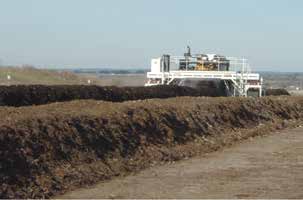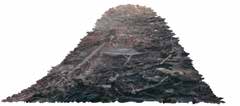chAPter 13 Making and using CoMPosts
coMPostInG deAd AnIMALs
It is possible to compost dead farm animals, which are sometimes a nuisance to get rid of. Chickens and even dead cows have been successfully composted. Cam Tabb, a West Virginia beef and crop farmer, starts the process for large animals by laying the carcass, which has been in the open for one day, on a 3- to 4-foot bed of sawdust and horse manure—a good insulating material for the foundation. Then he covers it with 3 to 4 feet of sawdust and horse manure. He turns the pile after three or four months, although it can be left for months without turning (the Cornell Waste Management Institute recommends letting it sit for four to six months). After turning, he places more sawdust and horse manure on the surface to cover any exposed materials from the decomposing animal. Other materials with lots of available energy for organisms to use to help decomposition, such as corn silage, can also be used for the base or pile covering. The pile should be shaped as a pyramid so as to shed water, and when the animal is placed in the pile, there should be at least 2 feet of base material between the animal and the outside of the pile.
chimneys all next to each other. Oxygen moves into the
Turning the Pile
pile as carbon dioxide, moisture, and heat rise from it.
Turning the composting residues exposes all the materi-
The materials need to fit together in a way that allows
als to the high-temperature conditions at the center
oxygen from the air to flow in freely. On the other hand,
of the pile, and heat convection further exposes upper
it is also important that not too much heat escape from
reaches of the pile (figure 13.3). Materials at the lower
the center of the pile. If small sizes of organic materials
sides of the pile often barely compost. Turning the pile
are used, a “bulking agent” may be needed to make sure
rearranges all the materials and creates a new center. If
that enough air can enter the pile. Sawdust, dry leaves,
piles are gently turned every time the interior reaches
hay, and wood shavings are frequently used as bulking
and stabilizes for a few days at about 140°F, it is possible
agents. Tree branches need to be “chipped” and hay
to complete the composting process within months, all
chopped so that these ingredients don’t mat and slow
other factors of moisture and aeration being optimal. On
composting. Composting will take longer when large
the other hand, if you turn the pile only occasionally, it
particles are used, especially those resistant to decay.
The pile needs to be large enough to retain much of
the heat that develops during composting, but not so
MInIMuM turnInG technIque
large and compacted that air can’t easily flow in from
Farm-quality composts can be produced by turning
the outside. Compost piles should be 3 to 5 feet tall and
the pile only once or twice. You need to carefully con-
about 6 to 10 feet across the base after the ingredients
struct the pile—building it up to reasonable dimen-
have settled (see figure 13.2). (You might want it on the
sions, using and thoroughly mixing materials that give
wide side in the winter, to help maintain warm tempera-
good porosity, and making sure the pile stays moist. A
tures, while gardeners can make compost in a 3-foot-tall
pile that is uniformly heating is getting sufficient air to
by 3-foot-wide pile in the summer.) Easily condensed
decompose, and therefore may not need turning. As
material should initially be piled higher than 5 feet. It is
the heat declines, the pile may be getting too dense or
possible to have long windrows of composting materials,
not getting sufficient air, and it may need to be turned.
as long as they are not too tall or wide.
144
Building SoilS for Better CropS: SuStainaBle Soil ManageMent













